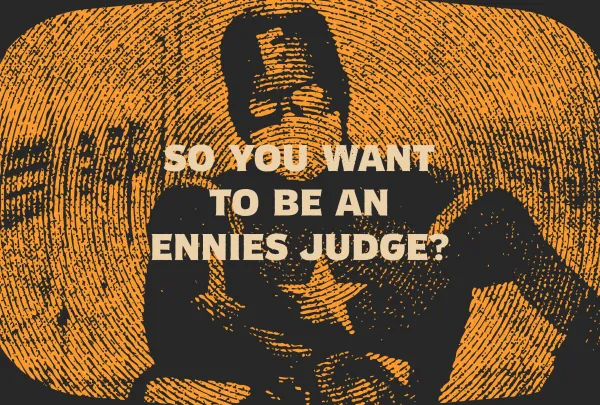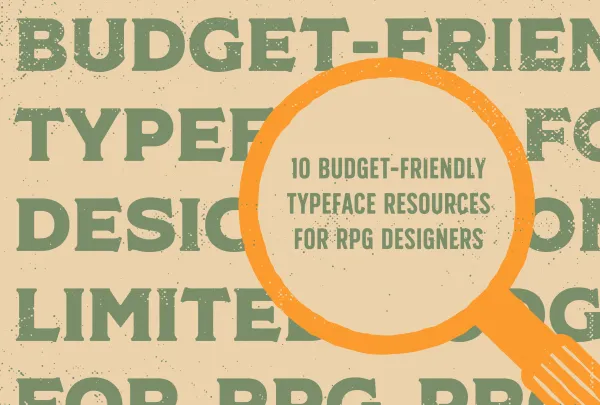Stop Hiding the Apes in Your RPG
How to show the cool and important parts of your game without muddling the work, burying the lede, and creating more noise.

But first, some monkey business.
Ignoring the thesis of this experiment (and its book), which is its own thing, one takeaway is this: The important elements in a composition can slip past the audience. It can be anything, even the thing you told them to look for. The number of passes, the player who shuffled out of frame, the color-changing curtains, or the ape who casually strolled into frame, beat their chest, and walked off.
When I watched this video, I didn't miss the gorilla, but I miscounted the number of passes. Nearly 50% of the audience misses the gorilla. The other 50% misses something else because of the gorilla.
This brings me to roleplaying games. After reading literally hundreds of rpg books for the Ennies, The Awards, and Explorers Design—I've noticed a theme:
You're hiding your apes. You're burying the lede. You're muddling the work. You're drowning the signal in noise.
This goes both ways. Many of you distracted the audience by making them look for one thing while the other interesting things passed by. Or you wanted them to know something, but you put a bunch of shiny distractions around it. Your message got lost in the noise.
Accidentally hiding the ape is easier in rpgs.
Unlike videos, novels, and video games—the large swath of our audience is several degrees of separation from our work. Despite some allusions to the contrary, we're not directors or novelists, we're more like screenwriters or playwrights—we have to rely on someone else to transmit the work. And that transmission will include editing, framing, and color correction outside of our control.
If we want the players to see the ape in our work, you have to make sure the ape gets seen (and prioritized) by the player reading it.
To that end, our craft often has many apes all at once. There's the main idea of the game we want to convey, the important rule on the page, or the singular detail about a monster or NPC. In this article, we're going to use the ape as a metaphor. What's the interesting thing we want people to see? And how do we make sure they don't miss it or get distracted by unauthorized apes?
Here are just a few examples of hidden apes with suspected causes...
Ape #1: The main idea of your game.
I cannot count the number of games that forget to say what they are. Is this something we play? What is the game about? What do the players do? The most important ape in all of roleplaying games is the paragraph that gets to the point.
You do not have to state your business in the first page or even the second page, but you have to get to it. The first ape is the game itself. It can be overt or subtle. Didactic ("In this game you...") or socratic ("But in this world, there are characters who...").
Here are things that many designers hide their game behind:
- Too much setting. The setting makes or breaks the game, but until the audience has a character to inhabit, the lore is burning on borrowed time. Every page of setting and lore loses power without its main characters and conflict.
- Too much metatext. Your game is inspired by a personal experience, built on something else, compatible with other works, and you have a lot of goals to list, and people to thank—and none of those things are the game. There's a reason why most forewords in novels get skipped. In rpgs, it's harder for audiences to know when your foreword ends and the game begins. Keep it short or integrate it after the ape.
- Assumptions. The hardest ape to point to is the one that isn't there. Don't forget to communicate the main idea at some point. This doesn't mean you have to explain what an RPG is, but you should probably convey there is a game here before you jump into character creation or worldbuilding.
Ape #2: The important rule or detail in your game.
What is the defining rule or procedure of your game? The thing that if it's missed, players won't actually engage with the game's core idea or coolest feature? This is the ape most often hidden by bad information design, writing, and layout. It's also the one found and fixed by playtesting and hiring an editor.
Here are things designers hide their rules behind:
- Other rules. You need your audience to understand what is singular and what is dependent. What rules are core rules? What rules take priority? What rules belong with each other? Basic design principles and following Gestalt theory will make the rules that matter stand out.
- Optional rules. This is a common issue with games that try to be everything to everyone, or get bloated from crowdfunding stretch goals. Keep the system's core simple and singular—at least until the index. Every alternative framework, rules system, and optional setting stretches the game out. Imagine trying to teach Chess to someone and giving them every variant and legendary move as you explained the difference between a rook and a bishop.
- Overwritten rules. The first of any system tend to be wordy. In theory, redundancies ensure nothing is misunderstood, but in reality it can exhaust the reader and trigger skimming. This was a common complaint with early Powered by the Apocalypse games that wanted to onboard players from D&D and other big box games. At the time, it was probably important to over stress fiction-first rules, but nowadays those overly detailed explanations tend to make the books and their rules feel bloated.
Ape #3: The cool evocative detail in a monster, room, or npc.
This one applies most of all to traditional elf games. What must be understood about a room, character, or faction in order for it to facilitate play? What is the lever, purpose, or idea behind this thing?
This ape sits at the center of the debate between "dungeon keying" and formatting. What transmits the message best? Some would argue it's a more traditional paragraph structure with a narrative flow (Like what you find in Wolves of the Coast by Luke Gearing or Prison of the Hated Pretender by Gus L). Others use a more granular approach with bolded keywords, lists, and nested information (Like what you find in Another Bug Hunt for Mothership or Halls of the Blood King by Diogo Nogueira.)
In my experience, both approaches work. Miscommunication doesn't stem from the format but in the execution. Here are things that hide your cool details in adventure design:
- The detail isn't evocative. If you're detail has a lot of supporting words, you need stronger details. This is all about economy. A single sentence is fine, but pages and pages of text add up, so you want to be pithy. For example, the giant isn't "walking with big, slow, clumsy steps" he's lumbering. The room isn't "stocked with 36 pikes, 27 polearms, and 38 spears on 6-8 wooden racks," it's loaded with racks upon racks of polearms. (That last one is for my fellow AD&D survivors. Gygax wrote his adventures like the characters were dungeon delving auditors.)
- There are too many details. The audience's attention is finite. The more details there are, the more those details have to compete for attention. This is similar to the "the signal is weak" except it's more about the content rather than the articulation. How many things do you want to convey? If one thing is especially important, you probably want it to be noticeably singular. My article, Design the Dungeon with Numbers covers this in detail.
- The order of details is wrong. You do not want to put the ape last if there's any chance of forgetting it's there. Especially if the apes are literal. There's an argument to be made for dramatic effect, but when it comes to playability, leading with the most important thing is often the best way to ensure it maintains that priority.
Enough with the metaphor already.
There are many ways we undermine our work. We can bury its most important aspects under other things, make it overly complicated, or make it blend in. If I can only impart one piece of advice it's this:
Make your cool thing the main thing. Don't undersell it, demote it, or delay it.
Put your apes in the spotlight and give them the stage. If the game has a cool premise, open with that cool premise. If the game has a defining mechanic, give that mechanic its own page, graphic, or play example. And if your dungeon has the coolest 1d4 white apes ever put to the grid—give them crowns and let them rule the kingdom.
Until next time, never stop exploring.
Additional Reading:




Explorers Design is a production of Clayton Notestine. If you liked this article, please consider liking, sharing, and subscribing. Members who pay $5/month also get access to additional tools, templates, and inspiration.








